

FRIULIAN DOLOMITES, CAVALLO AND AND CANSIGLIO
A MOUNTAIN FULL OF EXCITEMENT
FRIULIAN DOLOMITES, CAVALLO AND AND CANSIGLIO
A MOUNTAIN FULL OF EXCITEMENT
THE EXPERIENCES ONE CAN HAVE IN FRIULI VENEZIA GIULIA
INTRODUCTION FAMILY EXPERIENCE
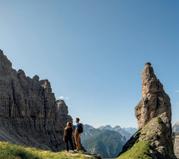
PURE NATURE, DEEP-ROOTED TRADITIONS
Page 4/5

DISCOVERIES TO SUIT ALL NEEDS
Page 8
REFUGES AND MOUNTAIN HUTS IN THE AREA
Page 9
WONDERS OF WOODS AND FORESTS
Page 9
THE PARK’S WILDLIFE
Page 10
CLAUT SCULPTURE
PARK
Page 11
A TREE VILLAGE
Page 12
EMERALD WATERS
Page 12
SUSPENDED ON TREES
Page 13
A JOURNEY THROUGH PRIMORDIAL ELEMENTS
Page 15
ACTIVE EXPERIENCE BIKE EXPERIENCE
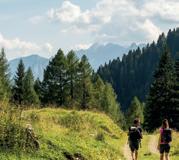
ADVENTURES IN THE FRIULIAN DOLOMITES PARK
Page 18
PALÙ DI LIVENZA
PILE-DWELLING SITE
Page 19
PIANCAVALLO: GREEN WELLNESS PATHS AND MOUNTAIN HUTS
Page 20
WALKING THROUGH THE SOUL OF THE DOLOMITES
Page 21
EXPERIENCE WATER EMOTIONS
Page 22
VISITOR CENTRES AND INFORMATION POINTS OF THE FRIULAN DOLOMITES PARK
Page 23
ON THE TIP OF YOUR HANDS
Page 24
THE MAGIC OF SNOW
Page 25

TWO WHEELS FOR ALL TASTES
Page 28
ROAD CYCLING AND MTB
Page 29
ART&CULTURE EXPERIENCE EVENTS
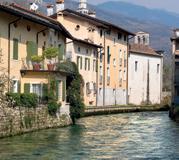
ERTO AND CASSO, MEMORIES OF LIFE
Page 32
CAVA BUSCADA AND ITS FOSSILS
Page 33
VAL COLVERA AND ITS VILLAGES
Page 34
ONE STEP AFTER ANOTHER TO ANDREIS
Page 35
POLCENIGO, ONE OF THE MOST BEAUTIFUL VILLAGES IN ITALY
Page 36
DISCOVERING CANEVA
Page 37
AVIANO
Page 38
THE ANCIENT SETTLEMENT OF BUDOIA
Page 38
SAN CRISTOFORO TRAIL
Page 39

FLAVOURS OF AN AUTHENTIC WORLD
Page 42
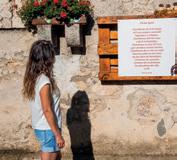
VISITING MUSEUMS
Page 46
THE ‘FILO DI MOSAICO’ PROJECT
Page 48
POETRY AND MEMORIES IN ANDREIS
Page 48
THE UNFORGETTABLE VAJONT DAM TRAGEDY
Page 49
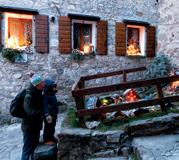
EVENTS
Page 52

PURE NATURE, DEEP-ROOTED TRADITIONS
At the western edge of Friuli Venezia Giulia there is an unspoilt area where landscape richness combines with a widespread network of ancient towns and villages. Here, traditions that have been preserved with care and meticulousness and handed down from times now forgotten. The Friulian Dolomites – UNESCO World Heritage Site since 2009 – and the Cansiglio and Cavallo areas are full of valuable jewels that just await to be visited: Erto and Casso, united by the Vajont dam disaster, or Frisanco and Poffabro, wonderful examples of the mastery that permeated everyday life in this region. Barcis and Andreis are also worth a stop: in these places nature imposes its presence with grandiose natural works. Val Tramontina stretches towards the plain, carrying towards the valley the emerald waters that have made it famous throughout Europe.
Other small urban areas further east such as Forni di Sopra, the pearl of the Friulian Dolomites, or Forni di Sotto, with its ancient fountains and its distinctive villages, are notable destinations.
The Mount Cavallo massif is located in the municipality of Aviano, known for the summer and winter tourist settlement of Piancavallo. In addition to nature, tourists can also find sites of historical and cultural relevance such as Budoia, an ancient prehistoric settlement. Between Caneva, the fortified town, and Polcenigo, one of the Most Beautiful Villages in Italy, is the pile-dwelling site of Palù di Livenza – UNESCO World Heritage Site since 2011.



FAMILY EXPERIENCE
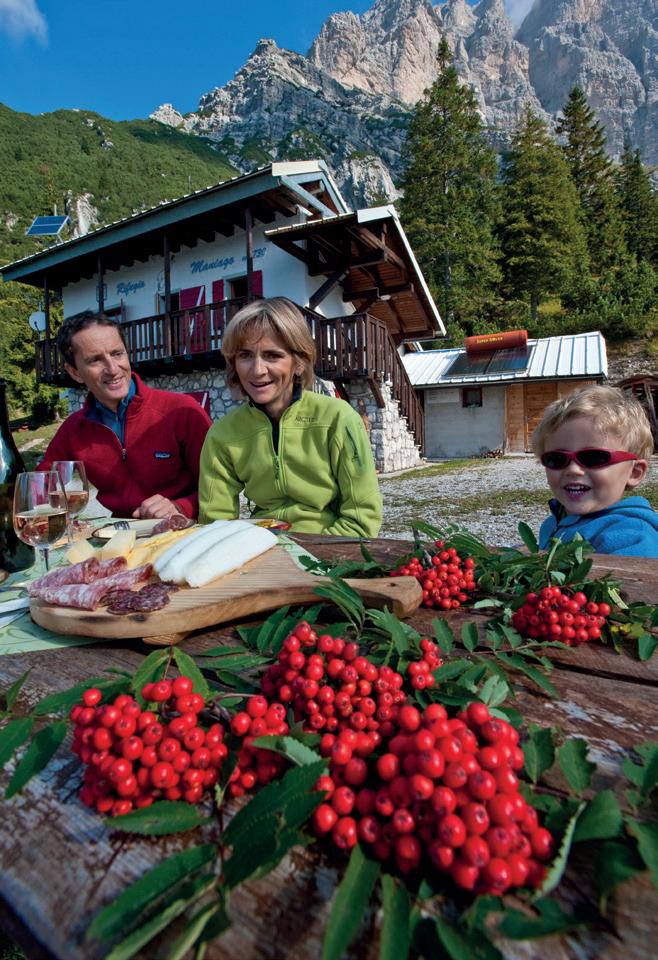
DISCOVERIES TO SUIT ALL NEEDS
Nature, history, art, traditions and typical products: these are the ingredients that make this area particularly suitable for families with children and teenagers. The elevations of the Friulian Dolomites were home to numerous dinosaurs as they roamed in search of food. It is precisely one of these theropods, large bipedal carnivores with three-toed hind legs, that left its imprint in the rocks near Casera Casavento. Discovered by a group of schoolchildren in the 1990s, the fossil trace of the dinosaur is one of the wonders of the area and is so well preserved that it seems to have been imprinted just recently.
REFUGES AND MOUNTAIN HUTS IN THE AREA
The area is dotted with mountain huts and refuges at high altitudes that make families always the protagonists of new adventures. The natural areas in here are made even
more beautiful by a range of fun and entertaining activities for the whole family, in contact with unspoilt nature.
WONDERS OF WOODS AND FORESTS
A stone’s throw from Lake Barcis lies the Prescudin regional forest, the perfect place for children, families and all outdoor enthusiasts: a small oasis of tranquility that can only be reached on foot via an easy route suitable for everyone. The Cansiglio
Forest is a true natural jewel that deserves to be discovered. Also known as ‘Bosco da reme di San Marco’, this forest has a longstanding history linked to the Republic of Venice, which used its wood to build ships.

Barcis Lake

THE PARK’S WILDLIFE
Established in 1996, the Friulian Dolomites Park has among its priority objectives the conservation and protection of the animal species hosted. The Andreis Bird Area, located a short distance from the town, is dedicated to the recovery of falconiformes and wild birds victims of accidents or debilitating illnesses. The aviaries host numerous species inhabiting the natural context of the Friulian Dolomites, including the Golden Eagle, symbol of the Park.
The Pianpinedo Wildlife Park hosts numerous wild animal species belonging to the Dolomites, such as deer, ibex, roes and chamois. Besides casually bumping into these animals in nature, the Pianpinedo visitor centre proposes the ‘Nature through the senses’ experience: visitors are given the chance to experiment with the activities of these animals, listen to their voices, admire their tracks and smell the scents of the park’s vegetation.
Ibex

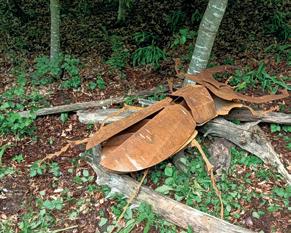

CLAUT SCULPTURE PARK
Along the ring path surrounding Claut, families can admire ten impressive animal sculptures that populate the woods, pastures and streams of the area.
Made by ten local artists, these modern totems in metal, wood, straw and fabrics represent a wolf, an ibex, a butterfly, a stag beetle, a trout, a dipper, a bear, a deer and a capercaillie.
Not only are these sculptures artistic
works, but they are also part of an educational path designed for schools and families, as visitors can virtually interact with the animal depicted.
The route can be further enjoyed with CLAPP, a mobile application which allows chatting with the animals depicted in the sculptures and take part in a digital treasure hunt.
Claut sculpture park
A TREE VILLAGE
As famous mountaineer and writer Julius Kugy once said: ‘You really learn to know a mountain when you sleep on it’. This and much more is possible by staying at the Tree village in Claut: an entire village of houses built on trees, located inside a one-of-a-kind theme
EMERALD WATERS
Within a series of severe and uncompromising mountains, the secluded Val Tramontina is deeply marked by the Meduna Torrent, whose waters have been carving their way towards the sea
park, where you can have fun and experience nature in freedom inside the Organic Garden, the Open-Air Woodcutter’s Museum, the Botanical Trail and the Nordic Walking Training Centre.
for millennia. In this corner of paradise the rapids of the stream sometimes calm down and give rise to incredible natural pools: the Emerald Pools.

SUSPENDED ON TREES
Near the town of Piancavallo, in a wonderful beech forest, is the Rampy Park, one of the largest parks in Italy. Here, among countless courses for adults, families, teenagers and children, you can spend many hours of fun without ever stepping ashore. All the activities and games can be experienced in complete safety and in an environmentally friendly and sustainable way A stone’s throw from the Tagliamento river, in the spectacular setting of Forni di Sopra, there is a place where fun runs among the treetops:
it’s the Dolomiti Adventure Park, which winds between dozens of platforms installed at various metres height, using the very tall trees of the Dolomite forest as supporting columns.
Inside the park, you will find numerous routes of varying difficulty, specifically designed to guarantee safe fun for adults and children, ranging from Tibetan bridges to suspended nets and fun and adrenaline-filled zip lines.

Rampy Park


A JOURNEY THROUGH PRIMORDIAL ELEMENTS
Thanks to the perseverance of its water and the relentless work that has lasted for millennia, the Cellina Stream has shaped one of the most majestic spectacles of the entire Alpine arc: the Forra del Cellina, a ravine decreed Natural Reserve of Friuli Venezia Giulia since 1998 and included in the geosites of national interest
Managed by the Friulian Dolomites Natural Park, the ravine is a canyon formed by steep rocks that fall vertically into the crystal-clear stream. The old road can only be travelled on foot while wearing a protective helmet; to safely cross the Tibetan bridge, wearing mountaineering helmets and harness is mandatory.
The Tibetan bridge is one of the most exciting sections of the entire ravine, which crosses the gorge suspended from one bank to the other, offering elite and exclusive viewpoints above the crystalline waters of the Cellina. Another way to enjoy the views of the ravine and the surrounding landscape is to walk along the evocative and accessible Dint path.
If you wish to explore the area in a comfortable and relaxing way, during the summer months a tourist train offers a panoramic journey through the towns of Barcis and Andreis.


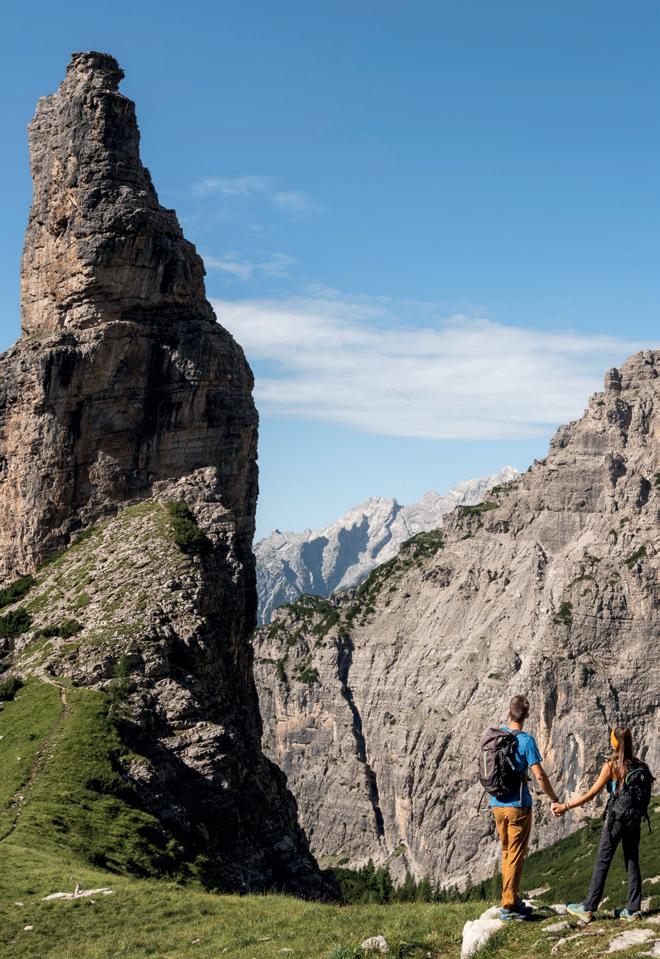
ADVENTURES IN THE FRIULIAN DOLOMITES PARK
A UNESCO Natural Heritage Site, the Friulian Dolomites Natural Park is the largest of the natural parks of Friuli Venezia Giulia, whose built-in symbol is the bell tower of Val Montanaia, a spectacular 300-metre-high spire which overlooks the namesake valley.
The Park extends over a surface area of 36,950 hectares and includes the areas of Valcellina (Andreis, Barcis, Cimolais, Claut, Erto and Casso), Val Tramontina (Tramonti di Sopra and Tramonti di Sotto), Val Colvera (Frisanco and Poffabro in the Pordenone area) and the upper Tagliamento Valley in Carnia, Forni di Sopra and Forni di Sotto.
The Parco Outdoor programme makes available a rich and varied schedule of walks, excursions and special activities taking place throughout the year together with the Park guides – real mountain professionals. Get ready to live unforgettable moments amidst magical landscapes, impressive Dolomite peaks, colours, shapes and images that only unspoilt nature can provide.

PALÙ DI LIVENZA
PILE-DWELLING
SITE
In the wetland and marshy area extending between the municipalities of Caneva and Polcenigo, in the area of the Livenza river springs, is the Palù di Livenza pile-dwelling site, one of the most interesting Neolithic pile-dwelling sites in northern Italy, inscribed on the UNESCO World Heritage List in 2011. This area was inhabited by the last hunter-gatherers during the final phase of the Palaeolithic, the Lateglacial and the final phase of the
Neolithic, when a pile-dwelling site developed in the wetland area. The Palù wetlands offer numerous nature trails to explore the rich biodiversity of the area and observe the variety of flora and fauna, including marsh birds and hygrophytic plants12. During the summer, you can explore the Livenza river in a peaceful and sustainable way aboard the free electric boats.
Palù di Livenza

PIANCAVALLO: GREEN WELLNESS PATHS AND MOUNTAIN HUTS
Piancavallo Green Wellness presents 20 ‘healing paths’ for a total of approximately 200 km and 11,000 metres of climbing. The project aims to promote an inclusive health-sports tourism for all, dedicated both to younger tourists and their families and to more expert hikers. These paths can be undertaken as an experience of wellness and self-care, in a true open-air, free and always accessible gym: an original way to propose a correlation between the usefulness of movement and the need of a balanced diet. The ‘Passeggiata delle Malghe’ is an easy and panoramic
circular excursion. Along the route you will come across the Casera Caseratte, the Casera del Medico and the Casera Barzan, stone structures that integrate perfectly with the surrounding environment and offer ideal stopping points to enjoy the splendid views of the Friulian plain.
Piancavallo

WALKING THROUGH THE SOUL OF THE DOLOMITES
The ring of the Friulian Dolomites is a trekking route that meanders into the soul of the Dolomite: paths and trails develop entirely within the namesake park, in a continuous vertical ecstasy. The original route is suitable to numerous variants and mountaineering climbs to the peaks and crosses the stony heart of the main mountain groups, connecting the refuges in the central area – the most fascinating of the Friulian Dolomites – in five days of Alpine raid.

Ring of the Friulian Dolomites
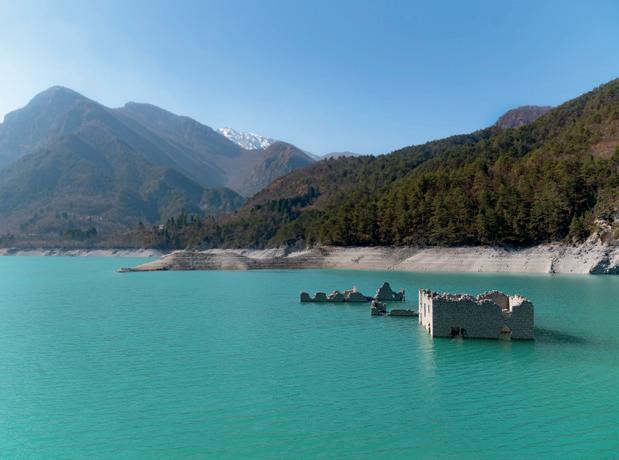
EXPERIENCE WATER EMOTIONS
In the heart of Valcellina, a bright green water basin welcomes visitors to the sunny Barcis basin. The orography of these mountains offers the expanse of the landscape in a parenthesis of forests and waters that meet, in the wide basin of Lake Aprilis, between days of relaxation and water sports. Towards the Pordenone plain, the long Ravedis basin is wedged inside the deep Cellina ravine. The best way to gain an unusual vantage point in such a primitive and fascinating natural setting is to explore its shores with a canoe
In Val Tramontina the Redona basin is a mirror nestled between rugged mountains. In dry periods, the ancient
village of Movada emerges from the water and brings back memories of a bygone era. Paddling on these waters while enjoying the relaxation of the surrounding mountains and the profound peace conveyed by the forests is a privilege for those who wish to regenerate deeply.
Over time, water has carved the limestone banks of the mountains and shaped numerous ravines: examples of this are the Molassa brook near Andreis, the Zemola stream at Erto, the Ciafurle brook at Claut, the Poschiadea brook at Forni di Sotto or the Tolina stream at Forni di Sopra.
Redona Lake
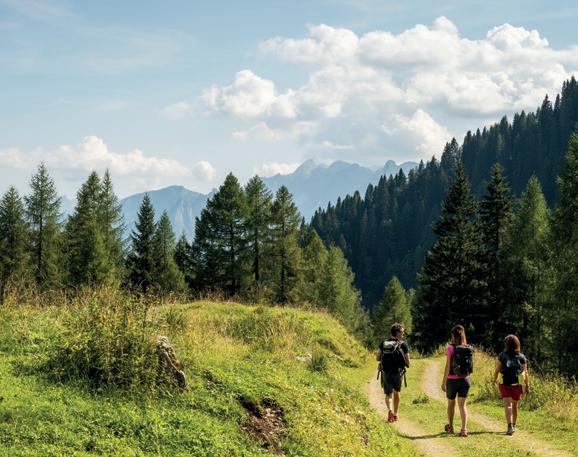
VISITOR CENTRES AND INFORMATION POINTS OF THE FRIULAN DOLOMITES PARK
The visitor centres of the Friulian Dolomites Natural Park are ideal reference points for those who wish to discover the extraordinary biodiversity and geological wealth of this area. Strategically located at various points in the park, these centres have dedicated information offices and offer detailed information on the flora, fauna and trekking routes that can be undertaken.
Each centre is equipped with interactive exhibits, information panels and multimedia materials that guide visitors to an understanding of the delicate ecological balance that characterises the Friulian Dolomi-
tes. The centres represent an ideal starting point for exploring the park in a conscious way, respecting the environment and its distinctiveness. www.parcodolomitifriulane.it/ centri-visite-e-punti-info
Forni di Sopra

ON THE TIP OF YOUR HANDS
The rock makes the Friulian Dolomites unparalleled and fascinating. The valleys alternate and stretch out with sheer walls, between slanted and steep sides, in a vertical world that offers some glimpses of the paths that climb the slopes of these choreographic ridges. Within this area, there are numerous walls equipped for sports climbing; some locations are internationally renowned for the type of climbing and the quality of the rock.
THE MAGIC OF SNOW
Piancavallo, at the foot of the Mount Cavallo and Col Nudo mountain range, is a ski resort that can meet the demands of all enthusiasts: 14 km of downhill ski trails offer descents for all technical abilities. The Funk Park offers skiers and snowboarders lines of varying difficulty to satisfy the desire for adrenaline rush. The pole also features of a slope for boardercross and skicross with parabolic curves, table-tops, jumps and moguls. But that’s not all: adults and children alike should not miss the Nevelandia winter playground and the rail bobsleigh of Piancavallo. Unforgettable experiences and fun in complete safety!
Claut is the ideal destination for ice skating and curling lovers and for families looking for fun. The Claut-Valcellina Ice Rink hosts training sessions, competitions and skating and curling tournaments, but for those who want to practice cross-country skiing, just leave the
sports hall to find an artificially snowed ring
Moreover, families can easily rent equipment to race on the toboggan, bobsleigh and life ring track.
Forni di Sopra, an Alpine pearl of the Friulian Dolomites, is one of the largest ski areas in the region: there’s a suitable slope for every skier and the right activity for every family.
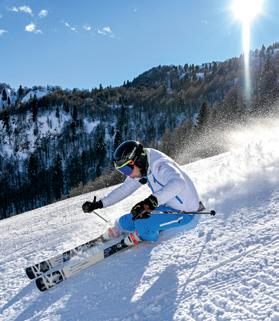



BIKE EXPERIENCE
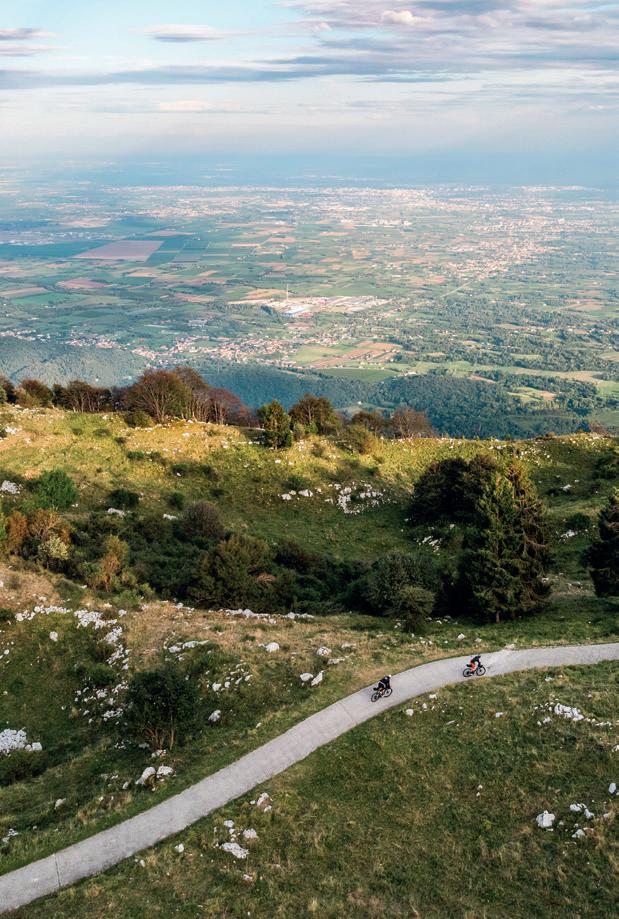
TWO WHEELS FOR ALL TASTES
The Friulian Dolomites, Cavallo and Cansiglio area offers cycling enthusiasts a one-of-akind place to practise their passion. A multifaceted landscape including roads, forest tracks, cycle routes and trails offers high quality tracks.
Venezia delle Nevi

ROAD CYCLING AND MTB
The cycle routes that develop around Lake Aprilis or between the towns of Claut and Cimolais are great opportunities to spend a few hours outdoors with your family. For fat-wheel enthusiasts, the orography of these areas draws a number of tracks and single tracks to try. Among the most evocative, which can be travelled by the less trained or with E-MTBs, the Delle Malghe tour in Forni di Sopra, the Sun route in Tramonti, the Lake Vajont tour near Erto, the Venezia delle Nevi road from Budoia to Piancavallo or the Cansiglio Ridge overlooking Aviano, Budoia, Polcenigo and Caneva, are just a few suggestions to enjoy the splendid views that these mountains offer.
The ring of mountain villages allows you to immerse yourself completely in the lush beauty of the Pedemon-
tana Pordenonese connecting Poffabro and Toppo, authentic gems of Friuli Venezia Giulia and inscribed on the list of the Most Beautiful Villages in Italy. The area is an interesting strategic point for MTB enthusiasts: routes for all difficulty levels can be travelled by mountain bike or e-bike. In the Roncjade area in Piancavallo you can try your hand at cross-country winter trails making their way through the beech forest. The ‘mountain hut tour’ is another excellent opportunity to relax surrounded by nature and can be done in several ways. The fittest can continue along the panoramic Pian delle More road leading to Lake Barcis, choose the Piancavallo - Cansiglio ridge or venture along the ‘Venezia delle Nevi’ road connecting the mountain hub with Dardago, for a more challenging experience.
Bike Park - Forni di Sopra


SLOW EXPERIENCE
ERTO AND CASSO, MEMORIES OF LIFE
Where the mountain meets the valley, the layer of snow is not so thick and the slopes somehow soften, there are the villages of Erto and Casso, in Val Vajont.
Inextricably linked to the Mount Toc tragedy, these villages still tell stories of people, habits and customs. In Erto, the Visitor centre of the
Friulian Dolomites Park It is one of the most important and complete documentation sites on the Vajont Dam disaster; its rooms host the memories of this land’s traditions, which disappeared on that distant evening with the landslide of Mount Toc.
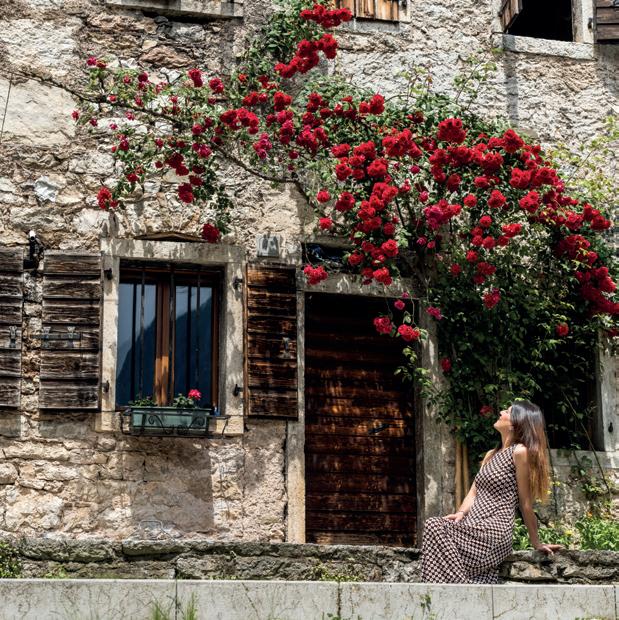
CAVA BUSCADA AND ITS FOSSILS
High above Val Zemola, a terrace between meadows and rocks hosts the old quarry. In operation from the 1950s until 1994, it is currently an integral part of an industrial archaeological trail which tells how the mining activity was the daughter of a fertile but strenuous mountain. In this mystical place, quarrymen toiled for decades to extract the valuable stone known as Rosso Ra-
mello, destined to adorn houses and palaces throughout Europe. These rocks derive from ancient marine deposits that accumulated on the ocean floor over 160 million years ago. Evidence of this marine legacy is provided by the numerous Ammonites that have been perfectly preserved among the rocks around the quarry.

Fossil
VAL COLVERA AND ITS VILLAGES
Once past the two tunnels of the main road, just beyond Maniago, an astonishing scenery opens up in front of you, a sort of journey through time welcoming visitors right from the first villages in the valley. This corner of the Pordenone area is part of the Friulian Dolomites Park and represents the ideal marriage between man and nature. These areas have been inhabited since Roman times and have maintained a privileged relationship with the local populations thanks to a balance of respect for traditions and the partial isolation of their hamlets. Listed among the Most Beautiful Villages in Italy, Poffabro is an enchanting village rich in narrow streets: the silence you can experience here recalls ancient atmospheres. Frisanco, the capital of Val Colvera, is not very far from Poffabro and has further surprises in store in its cobbled alleys, ranging from fascinating buildings to private squares.


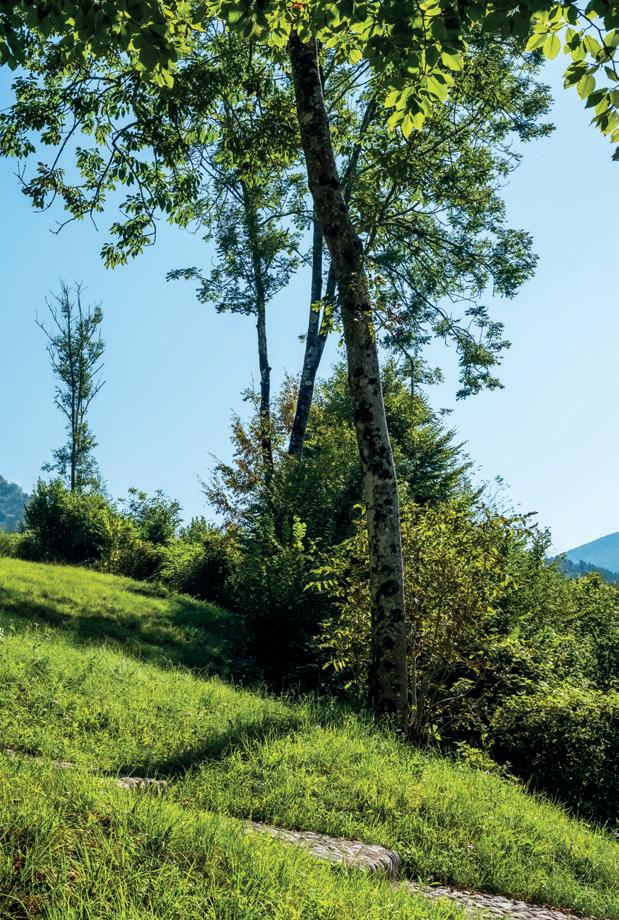
ONE STEP AFTER ANOTHER TO ANDREIS
Andreis is a small mountain village located a short distance from Lake Barcis, embraced by the peaks of Mounts Raut and Resettum watching over it from above.
Mule tracks, small churches, paths and fountains combine in a sort of open-air museum and today are brought back to life thanks to the trails of the Nordic Life Park, created following the principles of Nordic walking. 8 routes accessible to all are available, both for those who are approaching the discipline for the first time and for those who are already experienced and feel like working a little harder on the ‘fitness and sports’ paths.
POLCENIGO, ONE OF THE MOST BEAUTIFUL VILLAGES IN ITALY

geosite in Friuli Venezia Giulia, an astonishingly blue pool of water over 220 metres deep, the result of the karstic nature of these mountains. Polcenigo
Natural, historical and artistic elements allowed this village to be listed among the Most Beautiful Villages in Italy. We recommend you don’t miss the San Floriano Rural Park, which offers many evocative routes for family or group trips, as well as sports activities by bike, on horseback and in a canoe. The park is also a reserve where cultivation and breeding activities are carried out for educational and demonstration purposes, with the aim of recovering and enhancing local fruit and vegetable varieties and minor or endangered animal breeds.
The Gorgazzo springs are an important

Gorgazzo Springs
DISCOVERING CANEVA

The geographic area of Caneva is not only archaeologically relevant, but is also a land of ancient wines (Verdiso above all) and stories that mix different eras. Examples thereof are those told by the finds likely referable to the Neolithic Palù di Livenza pile-dwelling site, the remains of the Bronze and Iron Ages on the slopes of Col Castelir, the Palaeovenetian finds of Stevenà, Pradego and Villa, and the Longobard tombs of Stevenà.
An exception in these areas, Caneva is a fortified town which constituted the ancient Canipa, abandoned in
the 17th century and overwhelmed by the undergrowth.
Starting point for pleasant excursions in the woods or journeys through history, we recommend that you visit the picturesque ruins of the castle built around the year 1000 – probably on Roman foundations – and then Villa Frova, a stunning historical building with stylistic references to the Venetian Villas.
In Caneva you can also find the first giant bench of the Big Bench Community Project, installed in a vantage point which allows you to admire the entire surrounding landscape.
Caneva
AVIANO
The Aviano municipal area is distinguished by the Mount Cavallo massif at an altitude of 2,250 metres, the summer and winter tourist settlement of Piancavallo at an altitude of 1,250 metres, and a respectable historical, artistic and cultural heritage such as the Sanctuary of the Madonna del Monte consecrated in 1615. You shouldn’t miss a visit to the Castle of Aviano, dating back to the first half of the 10th century, or a stroll along the route to discover the 63 works by sculptor Riccardo Piter, most of which are exhibited in the Palazzina Ferro in Aviano.
Golf enthusiasts can also rejoice, as the municipality of Aviano boasts an 18-hole course set in a wonderful landscape at the foot of Piancavallo.
THE ANCIENT SETTLEMENT OF BUDOIA
The San Tomè valley is a valuable historical settlement, where bone, stone, ceramic and numismatic finds from the Neolithic to the Bronze and Iron Ages, up to the Roman and Longobard periods have come to light, arousing the curiosity of archaeologists, geologists and mountaineers. The little church of San Tomè was built there and still exerts considerable influence today. Also of note is the Ruial di San Tomè, an ancient waterworks, now restored, that used to bring water from the mountains to the villages of Dardago, Budoia and Santa Lucia.
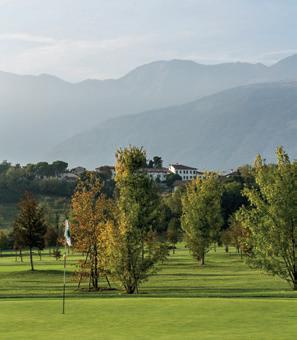

Golf Pordenone
SAN CRISTOFORO LONG TRAIL
The Way of Saint Christopher is a journey in a still little-known land, namely western Friuli, far from the most popular tourist destinations, among villages, hills and valleys that can tell a lot to those who are willing to listen.
The Way is divided into three routes: one in the Pedemontana area, one in the Magredi plain and the springs and the third in Val Meduna. The main route winds through the Pedemontana area and is the part
of the Way between the Livenza and the Tagliamento rivers which historically defined not only the physical but also the human geography of western Friuli. From Caneva to Spilimbergo, for over 150 kilometers, you can travel to discover these areas rich in history, culture and nature A one-of-a-kind experience for individuals and groups, families and schools.

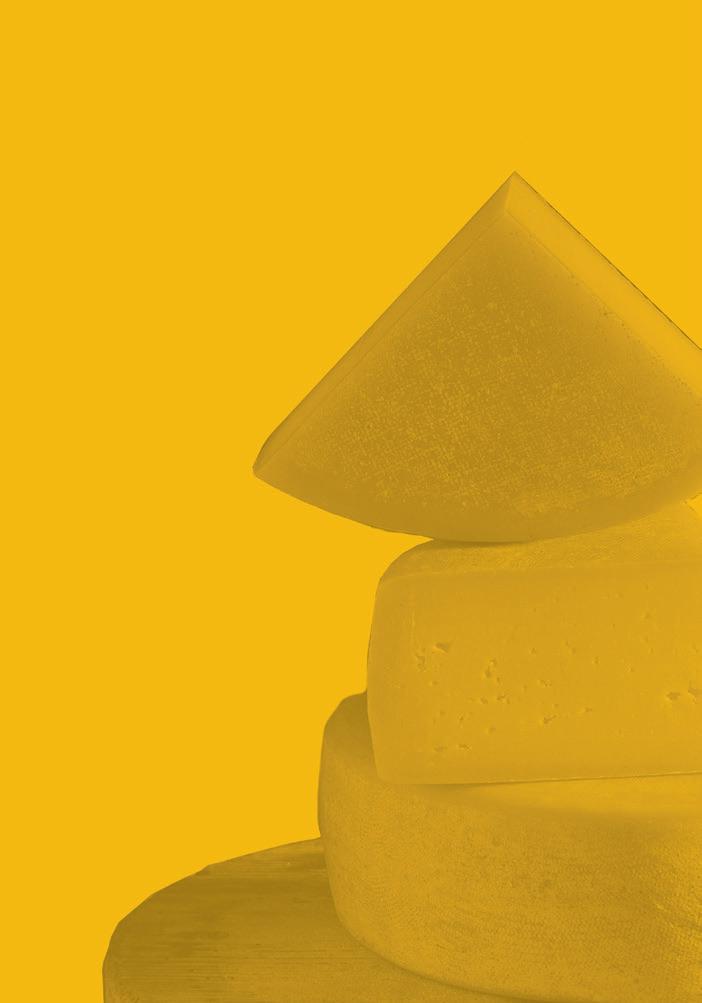

FLAVOURS OF AN AUTHENTIC WORLD
The dishes of this land are linked to their origins: scents, fragrances and aromatic extracts scrupulously guarded by the inhabitants of these valleys make up a traditional cuisine that is as typical as it is tasty.
Different Slow Food Presidia confirm the variety of these products. The Pitina is an exceptional product from the Pordenone Dolomite valleys protected with the PGI (Protected Geographical Indication) brand; another one is the Pestìth, a winter food typical of Valcellina made from the maceration of round purple collar turnips.
The Çuç di mont is a cheese also listed as Slow Food Presidium: to produce it, cows are sometimes fed a supplement of local hay or cereals.
Formadi Asìn and Formadi tal Cit also stem from the Alpine pasture tradition.
Famous for their unparalleled taste, these dairy products originated as an alternative method of preservation or as a reuse of defective cheeses. The period between August and September is when the Figomoro ripens in Caneva. This brownish fig is used as the main ingredient of delicious dishes, jams and sweet syrups.
Right in August in Caneva this product is the protagonist of the event ‘In Campagna con il Figo Moro’.
The wild herbs that grow in the meadows enrich the flavour of many traditional dishes such as the traditional Cjarsons, ravioli filled with potatoes, raisins and wild herbs seasoned with melted mountain butter and cinnamon.


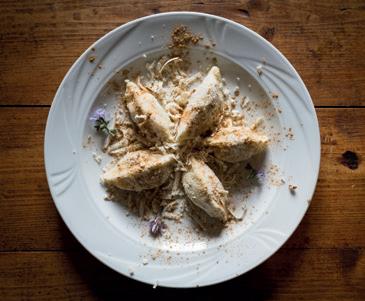
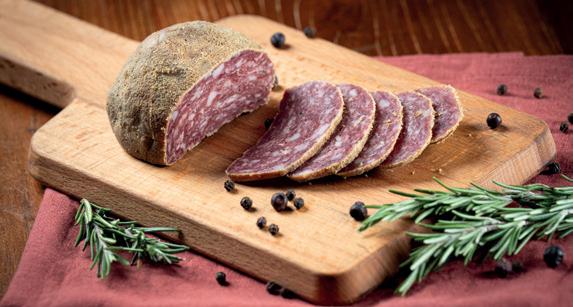
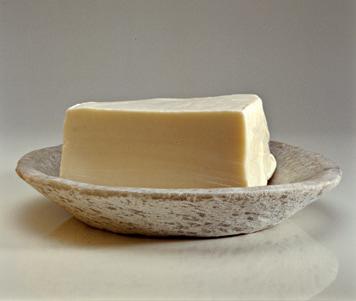

Sclopit (Silene)
Pitina
Cjarsons
Formadi Tal Cit
Formaggio Asino


ART&CULTURE EXPERIENCE
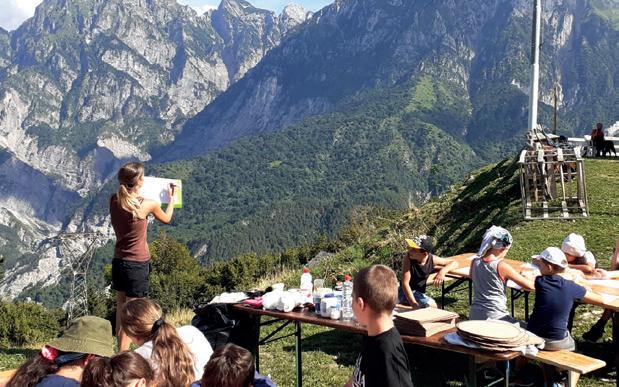

VISITING MUSEUMS
The Lis Aganis Ecomuseum of the Friulian Dolomites is dedicated to the enhancement, care and management of the cultural heritage of the area, with the aim of recovering, testifying to and passing on the historical memory, the life, the figures and the facts that link the communities to this land. This ‘widespread museum’ offers sites and small museums, each with specific themes and characteristics, organized into thematic itineraries. The Casa Clautana Museum, for example, displays how the women of Claut (and, more generally, of Valcellina) live, poor in material goods but rich in coherence, dignity and security as far as life choices are concerned. The Ciasa da Fum is one of the oldest buildings in Claut: this part of the itinerary clearly represents the typical architecture and lifestyle of the inhabitants of Claut. The exhibition ‘Da li Mans di Carlin’ in Frisanco displays
Lis Aganis Ecomuseum of the Friulian Dolomites
Lis Aganis Ecomuseum of
Friulian Dolomites

objects and buildings typical of the peasant civilization of Val Colvera, skilfully reproduced in 1:10 scale; the Mulino Sanchini in Polcenigo preserves numerous original objects linked to the production of flour.
The educational offering and the ecomuseum’s workshops tell and update the history of the Pordenone foothills and mountains: several itineraries explore specific aspects of the material and immaterial heritage, which may concern environmental, landscape, historical or cultural assets.
Curated by the Ecomuseum of the Friulian Dolomites, the PASSIparole programme is a fascinating initiative organized by its members that combines naturalistic and cultural excursions. A whole calendar of community walks is designed to help you discover, at a slow pace, the beauty and herita-
ge of the Friulian Dolomites through authentic and engaging itineraries. The manual skills handed down from the past have allowed the Talamini family of Claut to create the artisan laboratory of La Clautana, where the Scarpets (typical traditional and hand-made footwear) are brought back to life. The modern processes now used to produce them help maintain the comfort and origin of the materials used unchanged: natural, healthy and breathable. In the Friulian Dolomites area, the Fornese Rural Museum is also worth a visit. Located in the historical building La Casina da Vic, former social dairy of Vico, this facility allows visitors to discover the different facets of rural society.
Casa Clautana
THE ‘FILO DI MOSAICO’ PROJECT
In Tramonti di Sotto, in Val Meduna, the legend of the ball of wool whose thread never ended has become the heritage of this area and is synonymous with a resource that must be used collectively, as memories, knowledge and traditions must be preserved to pass them on to future generations. From these premises, the Filo di Mosaico project was born – a collective project that embraces the entire
old town centre of Tramonti di Sotto, leading visitors through its courtyards and houses.
The origin of the long mosaic, the ball of wool stands out on a wall near the Casa della Conoscenza, an archaeopoint that illustrates the archaeological finds of western Friuli, including the Longobard Necropolis of Tramonti di Sotto – an evidence that these areas were already inhabited in ancient times.
POETRY AND MEMORIES IN ANDREIS
In Andreis you can breathe fresh mountain air, even though the average altitude of the town is limited to 455 metres above sea level. This area is rich in natural resources and points of interest such as the Periadriatic Fault in the valley of the Susaibes brook – which goes from Andreis to Bovec in Slovenia – or the Avifauna Area for the recovery of wild birds in the Friulian Dolomites Park. Andreis is also home to the Museum
of Peasant Art and Civilization, where you can relive the atmosphere of the mountain huts in which dairy products were made, as well as of the Andreis cuisine with its fireplace, a place where the whole family used to meet and gather. The houses in Andreis are a living proof of peasant civilization and compete for the visitors’ gaze between stone walls and the linear dark shapes of the wooden balconies, called ‘daltz’.

Andreis

THE UNFORGETTABLE VAJONT DAM TRAGEDY
When arriving from Valcellina along the S. Osvaldo Pass or from the Piave valley going up the mountain from Longarone, the Vajont Dam stands silent as a skeleton from the past. The dam has become a real monument to the memory, so that what happened can remain in everyone’s mind and the 2,000 victims of that terrible tragedy are never forgotten. The visit can be preceded by the one to the Visitor Centre of Erto, where the permanent exhibitions ‘La Catastrofe del Vajont’ and “Vajont: immagini e memorie’ are in display in the building that housed the town’s elementary schools.

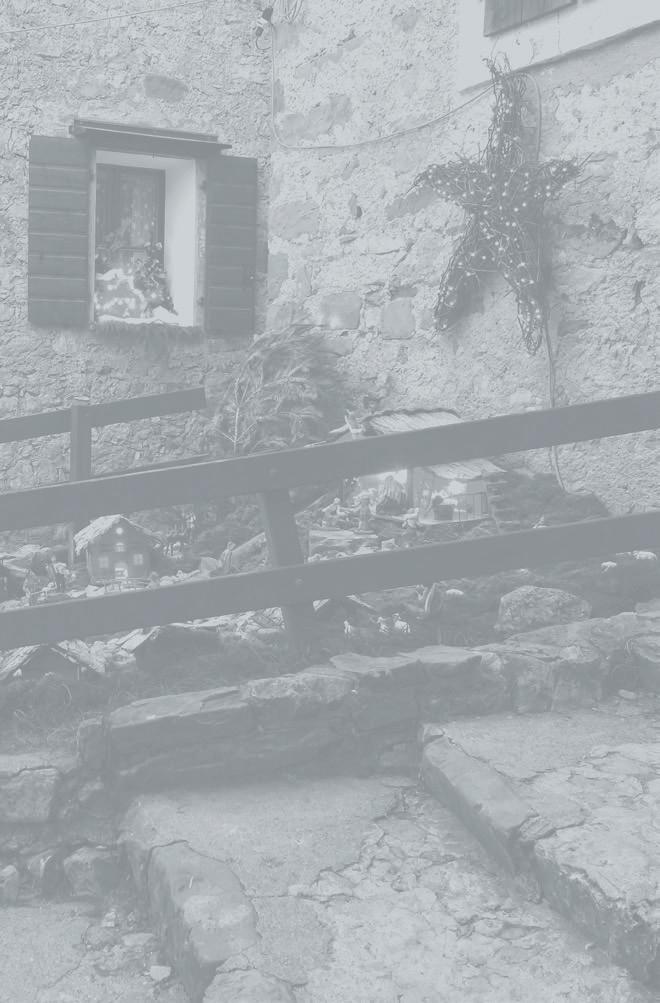
February – Piancavallo
TRANSCAVALLO
April – Aviano
AVIANO IN FESTA
April – Barcis e Claut DOLOVALLI FEST
April – Cimolais
FESTA DEL PESTITH E DEI FERMENTATI
Easter – Erto
I CAGNUDEI - SACRA RAPPRESENTAZIONE DEL VENERDÌ SANTO DI ERTO
Easter – Claut
LA SACRA RAPPRESENTAZIONE DELLA
PASSIONE DI CRISTO
June – Caneva
CASTELLO IN FESTA GIORNATA MEDIEVALE
July – Cimolais
LA CIMOLIANA
July – Frisanco
ARTIGIANATO NELLA FAVOLA
July, August, September – Claut VIVI CLAUT
July – Frisanco BROCANTE
July, August – Tramonti di Sopra FESTA DELLA MONTAGNA
July, August – Polcenigo
BLANC EUROPEAN FESTIVAL
August – Claut
ARIA DELLE DOLOMITI
August – Aviano - Piancavallo
FESTIVAL INTERNAZIONALE DEL FOLKLORE
AVIANO - PIANCAVALLO
August – Piancavallo RALLY PIANCAVALLO
August – Claut GRAN FONDO DOLOMITI FRIULANE BIKE
September – Polcenigo
352ª THÉST. ANTICA FIERA DEI CESTI
September – Cimolais
UNA MONTAGNA DI GUSTI
September – Budoia
MOSTRA MERCATO DEI PRODOTTI
AGROALIMENTARI, BIOLOGICI E DI QUALITÀ DEL FVG
September – Caneva POESIE AL MURO
September – Caneva
DA CANEVA A SPILIMBERGO SUL CAMMINO
DI SAN CRISTOFORO
September – Polcenigo e Caneva ALTO LIVENZA FESTIVAL
September – Frisanco and other places in the Valcolvera PAESI APERTI
October – Barcis FESTA D’AUTUNNO
October – Erto e Casso FIERA D’AUTUNNO
October – Erto e Casso
SIMPOSIO DI SCULTURA
December – Andreis
AD ANDREIS NEVICA LA FANTASIA
December – Aviano
LO SCRIGNO DEI PRESEPI AVIANESI
December – Caneva
BORGHI & PRESEPI
December – Polcenigo
MAGIA DI UN BORGO ANTICO_PRESEPI A POLCENIGO
December – Frisanco - Loc. Poffabro
POFFABRO: PRESEPE TRA I PRESEPI
ONE APP, INFINITE POSSIBILITIES
All trekking and cycling routes and all useful information and suggestions for your excursions at now your fingertips: with the FVG OUTDOOR app you can discover an entire area through the eyes and advice of those who live there. Whether you are a skilled cyclist or a novice hiker, a picturesque village enthusiast or an unspoilt nature lover, you will find everything you are looking for on our interactive map… and much more!


DOWNLOAD APP FVG OUTDOOR

A LISTING OF THE PROMOTURISMOFVG INFOPOINTS
Arta Terme Infopoint
Via Nazionale, 1 - 33022 Arta Terme (UD)
Tel. +39 0433 929290 | Cell.+39 335 7463096 info.artaterme@promoturismo.fvg.it
Aquileia Infopoint
Via Giulia Augusta, 11 - 33051 Aquileia (UD)
Tel. +39 0431 919491 | Cell. +39 335 7759580 info.aquileia@promoturismo.fvg.it
Cormons Infopoint
Piazza XXIV Maggio, 15 – 34071 Cormons (GO)
Tel. +39 0481 386224 | Cell. +39 335 7697061 info.cormons@promoturismo.fvg.it
Forni di Sopra Infopoint
Via Cadore, 1 - 33024 Forni di Sopra (UD)
Tel. +39 0433 886767 | Cell. +39 335 1083703 info.fornidisopra@promoturismo.fvg.it
Gorizia Infopoint
Corso Italia, 9 - 34170 Gorizia
Tel. +39 0481 535764 | Cell. +39 335 1084763 info.gorizia@promoturismo.fvg.it
Grado Infopoint
P.zza XXVI Maggio, 16 - angolo Portanuova, 26 34073 Grado (GO)
Tel. +39 0431 877111 | Cell. +39 335 7705665 info.grado@promoturismo.fvg.it
Lignano Pineta Infopoint (stagione estiva)
Via dei Pini, 53 - 33054 Lignano Pineta (UD)
Tel. +39 0431 422169 | Cell. +39 331 1435222 info.lignanopineta@promoturismo.fvg.it
Lignano Sabbiadoro Infopoint
Via Latisana,42 - 33054 Lignano Sabbiadoro (UD)
Tel. +39 0431 71821 | Cell. +39 335 7697304 info.lignano@promoturismo.fvg.it
Marano Lagunare Infopoint
Piazza Cristoforo Colombo - 33050 Marano Lagunare (UD)
Cell. +39 334 6835248 info.marano@promoturismo.fvg.it
Miramare Infopoint
Porta della Bora, adiacente all’ingresso del Viale dei Lecci
34121 Trieste Cell. +39 333 6121377 info.miramare@promoturismo.fvg.it
Muggia Infopoint
Piazza Marconi, 1 - 34015 Muggia (TS)
Tel. +39 040 9571085 info.muggia@promoturismo.fvg.it
Palmanova Infopoint
Borgo Udine, 4 - 33057 Palmanova (UD)
Tel. +39 0432 924815 | Cell. +39 335 7847446 info.palmanova@promoturismo.fvg.it
Piancavallo Infopoint
(stagione invernale ed estiva)
Via Collalto, 1 - 33081 Piancavallo - Aviano (PN)
Tel. +39 0434 655191 | Cell. +39 335 7313092 info.piancavallo@promoturismo.fvg.it
Pordenone Infopoint
Palazzo Badini
Via Mazzini, 2 - 33170 Pordenone
Tel. +39 0434 520381 | Cell. +39 335 1516948 info.pordenone@promoturismo.fvg.it
Sappada Infopoint
c/o Borgata Bach, 9 - 33012 Sappada (UD)
Tel. +39 0435 469131 | Cell. +39 335 1085932 info.sappada@promoturismo.fvg.it
Sistiana Infopoint (stagione estiva)
Sistiana, 56/B - 34011 Duino - Aurisina (TS)
Tel. +39 040 299166 | Cell. +39 335 7374953 info.sistiana@promoturismo.fvg.it
Tarvisio Infopoint
Via Roma, 14 - 33018 Tarvisio (UD)
Tel. +39 0428 2135 | Cell. +39 335 7839496 info.tarvisio@promoturismo.fvg.it
Tolmezzo Infopoint
Via della Vittoria, 4 - 33028 Tolmezzo (UD)
Tel. +39 0433 44898 | Cell. +39 335 7747958 info.tolmezzo@promoturismo.fvg.it
Trieste Airport Infopoint
Via Aquileia, 46 - 34077 Ronchi Adei Legionari (GO)
Tel. +39 0481 476079 | Cell. +39 334 6430667 info.aeroportofvg@promoturismo.fvg.it
Trieste Infopoint
Via dell’Orologio, 1 - angolo Piazza Unità d’Italia 34121 Trieste
Tel. +39 040 3478312 | Cell. +39 335 7429440 info.trieste@promoturismo.fvg.it
Udine Infopoint
Piazza I Maggio, 7 - 33100 Udine
Tel. +39 0432 295972 | Cell. +39 335 1088307 info.udine@promoturismo.fvg.it
HOW TO TRAVEL TO FRIULI VENEZIA GIULIA
BY CAR
Highway:
A4 Torino/Trieste
A23 Palmanova/Udine/Tarvisio
A28 Portogruaro/Conegliano
A27/A4 Trieste/Belluno
BY PLANE
Airport of Trieste www.triesteairport.it
40 km from Trieste and Udine
80 km from Pordenone 130 km from a Venezia 120 km from Lubiana
www.trenitalia.it
www.alpe-adria-radweg.com www.adriabike.eu
CREDIT
Archivio Parco Dolomiti Friulane, F. Lorenzi
Archivio Parco Dolomiti Friulane, L. Bincoletto
Archivio Parco Dolomiti Friulane, Fabiano Bruna
N. Brollo
F. Gallina
L. Gaudenzio
PromoTurismoFVG
Strategies, Development, Operations for Tourism
Sede Marketing: via Aquileia, 46 34077 Ronchi dei Legionari (GO) info@promoturismo.fvg.it
S. Giacomuzzi
A. Mimiola_Alvento Italian Cycling Magazine
L. Tessaro
M. Verin
